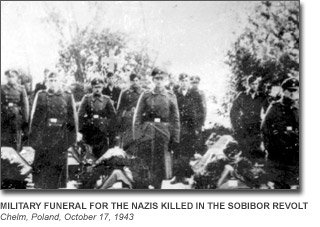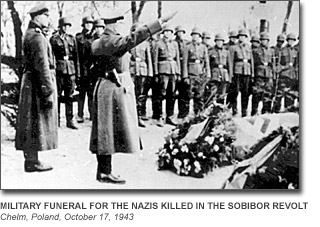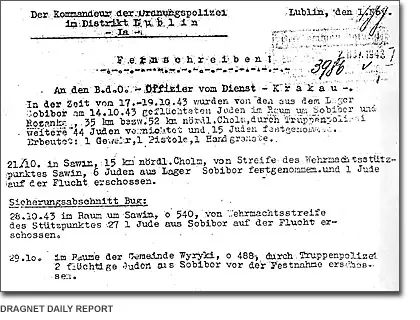The Aftermath of the Sobibor Revolt
(October-November 1943)

A quietness lay over Sobibor. The few Germans still alive, Erich Bauer, Karl Frenzel, Willy Wendland, Rechwald and Siegfried Wolf assessed the situation. The guards assembled, but many of their comrades were now gone. On those parts of the fences that remained standing and on the ground now torn by the explosions, bodies were lying scattered about.
Taken by surprise, the Germans were unable to comprehend the situation. Was this revolt accomplished by the wretched Jews alone or was it a planned military action with the help of outside partisans? They were in a panic. The camp telephone was not functioning and Frenzel called the nearby base of the Border Police and the SS Mounted Unit in Chelm from the village train station. He also sent a chaotic message to the Security Police headquarters in Lublin asking for immediate reinforcement to save the lives of the remaining Nazis: "Jews revolted ...Some escaped ...Some SS officers, noncoms, foreign guards dead. ...Some Jews still in camp. ...Send help."
The Commander of SS and Police forces in Lublin, Lieutenant General Jakob Sporrenberg, immediately informed General Frederick Krüeger in Krakow, the Commander of all SS and Police forces in occupied Poland of the Sobibor uprising and the Nazi casualties. His cable to them follows:
“October 14, 1943, at about 17:00 hours, a revolt of Jews in the SS camp Sobibor, 40 km north of Chelm. They overpowered the guards, seized the armory and after a shutout with the camp garrison, escaped in an unknown direction. Nine SS killed. One SS wounded. One SS missing. Two guards of non-German nationality shot to death.

Approximately 300 Jews escaped. The remainder were shot to death or are now in the camp. Military Police and armed forces were immediately notified and took over the security of the camp at about l:00 hours (1:00AM, October 15). The area south and southwest of Sobibor is now being searched by police and armed forces.”
General Hilmar Moser, wasted no time in ordering Major Hans Wagner, commander of the 689 Werhmacht Security Battalion in Chelm, to quell the uprising and capture those who had escaped by every necessary measure.
Help arrived quickly in the form of a small Border Patrol unit of seven men under the command of SS Untersturmfuehrer Adalbert Benda. Late that night, Major Eggert of the Security Police and Captain Erich Wullbrandt, an officer in the Security Police decorated with the highest German military honors, arrived.
SS Untersturmfuehrer Benda reported: ...During the mopping up of the camp itself, our men had to use arms because the prisoners resisted arrest. A great number of prisoners were shot: 159 prisoners were treated as ordered. All the men of the Einsatzkommando were equal to their task.
The next order of business was the pursuit.

For the Jews who had escaped, the next few weeks were terrifying. They were hunted by more than 100 regular soldiers, 100 mounted police and 150 Ukrainians and SS soldiers. On October 16 and 17, the second and Third Squadron of Mounted SS and Police added five hundred more men to the manhunt. This force was formidable enough; but one must add to it the auxiliary units, regional police units and local collaboration, aided by two Luftwaffe observation aircraft, to comprehend the odds against these Jews.
The bridges across the Bug river were guarded and traps were set on the crossroads. Circling in the forest, some Jews inadvertently returned to the camp area where they were spotted and caught.
The search was finally officially halted on October 2, but the escapees continued to be captured individually or in groups, and cables were sent regularly to Kraków as each of the escapees were caught.
The Security Zone Bug (Dragnet Daily Report) report pictured here reads:
In the period from October 17 - 19, 1943 Jews who escaped from Sobibor on October 14, were apprehended in the area of Sobibor and Rozanka, fifty two kilometers north of Chelm. The military police killed forty-four more Jews and fifteen Jews were taken into custody. Seized: one rifle, one pistol, one hand-grenade.
October 21, 1943 Sawin, fifteen kilometers north of Chelm, Wehrmacht posts in Sawin apprehended six Jews from Sobibor. One Jew was shot death attempting to escape.
October 28, 1943, o 540, in the area of Sawin, one Jew from Sobibor was shot in an escape attempt by Wehrmacht post 27.
October 29. 43, in the municipality of Wyryki, o 489, the military police apprehended two escapees from Sobibor. They were executed.
| The Jewish Side: | ||
| Original number of prisonsers at the time of the revolt |  | 550 |
| • Not able or willing to escape, including 30 in Lager I |  | (150) |
| • Killed in combat and mine fields |  | (80) |
| Number of prisoners to initially escape Sobibor |  | 320 |
| • Captured in dragnet and executed |  | (170) |
| Number of prisonsers to successfully escape Sobibor |  | 150 |
| • Killed fighting Germans as partisans or in the army |  | (5) |
| • Killed in hiding, mostly by hostile native elements |  | (92) |
| Number of revolt survivors to be liberated by the Allies |  | 53 |
| * Additionally, 9 Jews survived from earlier individual escapes, which makes a total of Sobibor survivors: |  | 62 |
| The Nazi Side: | ||
| Germans and Ukrainian guards on duty at the time of the revolt |  | 137 |
| Germans killed including 2 Volksdeutsche guard leaders |  | 12 |
| Germans wounded |  | 1 |
| Ukrainians guard killed |  | 8 |
| Ukrainian guards wounded |  | 12 |
| Ukrainian guards not accounted for...(Fled for fear of German reprisals) |  | 28 |
Word of the escape first got to the outside world through an October 25 cable send by the Polish underground (AK) to their government-in-exile in London: In an heroic fight with the Germans the Jews destroyed their place of torment.
This was the first and only case in which so many Nazis were killed by prisoners in a single action, in one day, during the Second World War. Bauer recalled in his post-war testimony:
...I transported seven coffins to the city of Chelm...The rest of the coffins came with the train to Chelm. Those I transported from the railroad station to the City Hall. In all, twenty-one or twenty-three persons were killed.
"
Auschwitz Commandant Rudolf Höss notes in his memoirs that The Jews (of Sobibor) were able, by force, to achieve a major breakout, during which almost all the German personnel were wiped out....
The uprising in Sobibor represented one of the most heroic pages in the anti-fascist resistance in World War II, as well as in Holocaust history as a whole. It was unique in its plan and execution and in successfully eliminating most of the SS staff in the camp.
As a result, the camp was closed. The area was plowed under and a Ukrainian Guard settled at the site.
On another level, the Sobibor Uprising had more far reaching and tragic repercussions. On October 19, 1943, the Sobibor revolt was discussed extensively at a meeting held in Governor General Hans Frank’s mansion in Kraków. In attendance were the chiefs of the Security Service and Police in the Generalgouvernement. Citing Sobibor as an example of danger they decided to accelerate the liquidation of the remaining Jews in camps in Lublin area. Himmler immediately ordered SS General Friedrich Krueger to carry out this policy.
Twenty days after the revolt, on November 3, 1943, under the code-name Erntefest (Harvest Festival), the liquidation began. The results were staggering: 10,000 Jews were killed at Trawniki, 18,000 at Majdanek and an additional 15,000 in other camps; a total of 43,000 killed in six days.
Source: Historical research of Thomas ‘Toivi’ Blatt, survivor of the Sobibor death camp who escaped during the uprising on October 14, 1943. Provided by his daughter Rena Smith.


